Not all native species of Australian birds have integrated as well as others with human populations. So on a visit to Australia you are most likely to see those that have adapted well to living alongside us, while others you might have to go on a hunt for off the beaten track a little. You can also check out my post on where to find the tiny Australian native birds of the Blue Mountains.
When you pay a visit to the Blue Mountains, keep an eye out and you will probably see some of these colourful characters!
This post contains affiliate links. Making a purchase through these links earns a small commission at no additional cost to you, and is a great way to show your support for this site.
Birds you may see on your Blue Mountains trip
Rainbow Lorikeet
There’s no mistaking this species of Australian native parrot which is common along the east side of Australia.
I have a soft spot for these bright birds, despite the slightly evil appearance cast by their red eyes. I have memories of family holidays to Queensland as a child where the birds are so familiar with tourists they land all over your head and arms. I am sure there is a photo of this somewhere. They are usually in pairs and very vocal, almost constantly chattering away at each other. Lorikeets are not sexually dimorphic, meaning you are unable to tell the difference between the male and the female without testing.
Lorikeets are nectarivores, so anywhere there are bright flowers there are likely to be Lorikeets not to far away. They even like lavender!
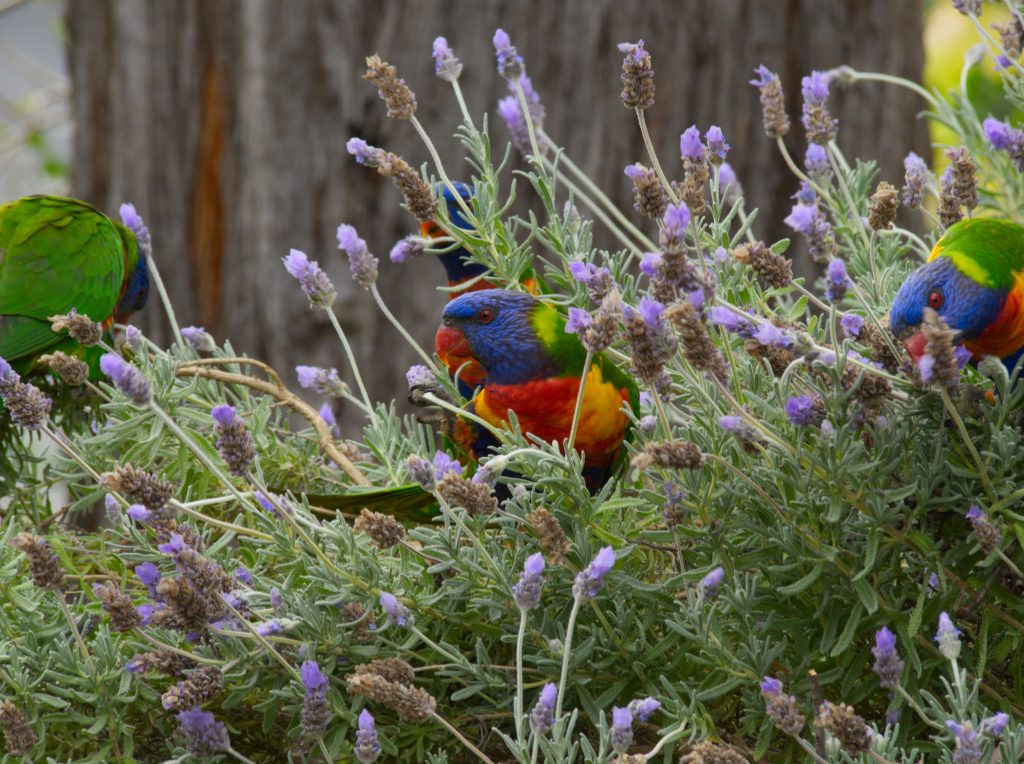
They make me giggle to watch them moving around on the ground, there is something about their body that looks slightly off balance like they are missing tiny front legs like a T-rex! They also tend to jump rather than move their legs individually.
I’ve been lucky enough to catch them hanging out preening each other in the native bottlebrush tree in my yard, which is super cute!
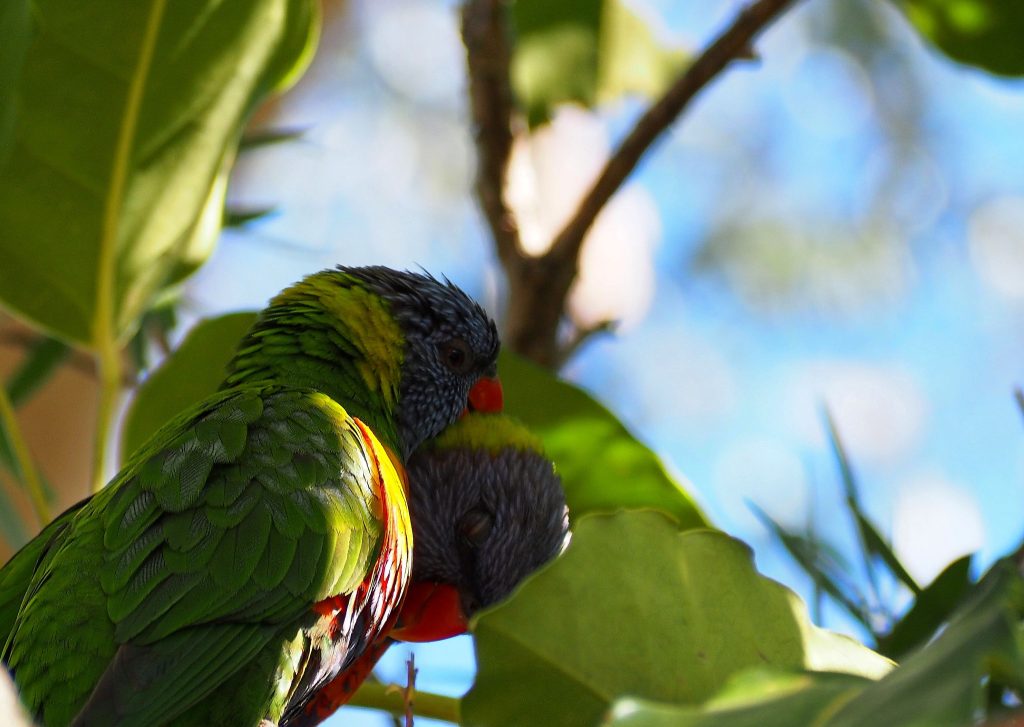
And one more, just because I love the detail in this photo and they are such photogenic little birds! You can just see the silver eye ring in the iris of this bird, indicating it hasn’t quite reached sexual maturity yet and is likely less than 18 months old.
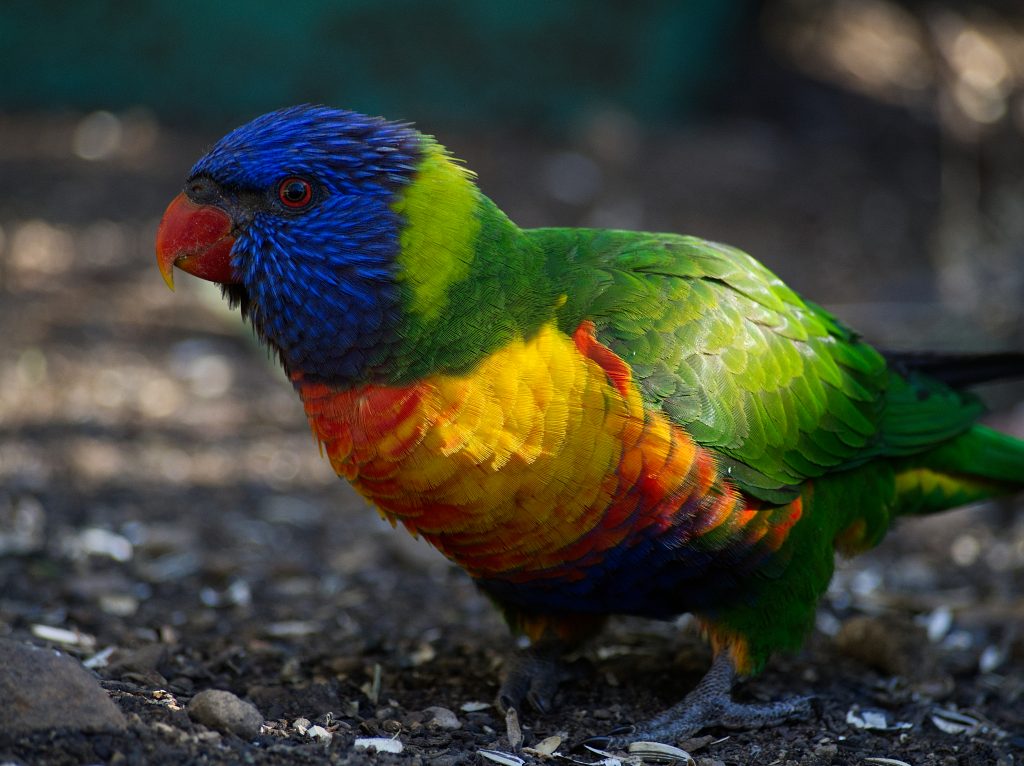
If you want a good giggle, check out the behaviour of this male Lorikeet while I was sitting outside with my coffee!
Australian King Parrot
Now these guys are my favourite! They don’t visit me as often as I would like, usually because I am inundated with Cockatoos and the King Parrots don’t seem to fancy them much, whereas the Lorikeets don’t care.
Larger than the Lorikeets, they are also found on the eastern side of Australia. They have also become the most comfortable with me.
One day when I was outside hanging up my washing a male flew to the nearby Frangipani and sat watching me. I thought it might be worth a go, so I put some seed in my hand and held it up to him and was delighted when he ate from my hand. After a while I sat by my pond, still holding out the seed. He flew to several spots around me and chirped down at me, never taking his eyes off me. And then he flew down to land on my hand. It was so unexpected that I didn’t even have my phone on me!
The next time it happened I had a whole group of them in the tree, and the Cockies were eating the seed from the ground. So I tried it again.
The females are the boldest, and several of them flew down with little hesitation and rotated while the others watched from the patio roof nearby. One or two females appeared dominant and would send the others off to hog their time with the seed in my palm. At one point I had both a male and female on my arm and hand.
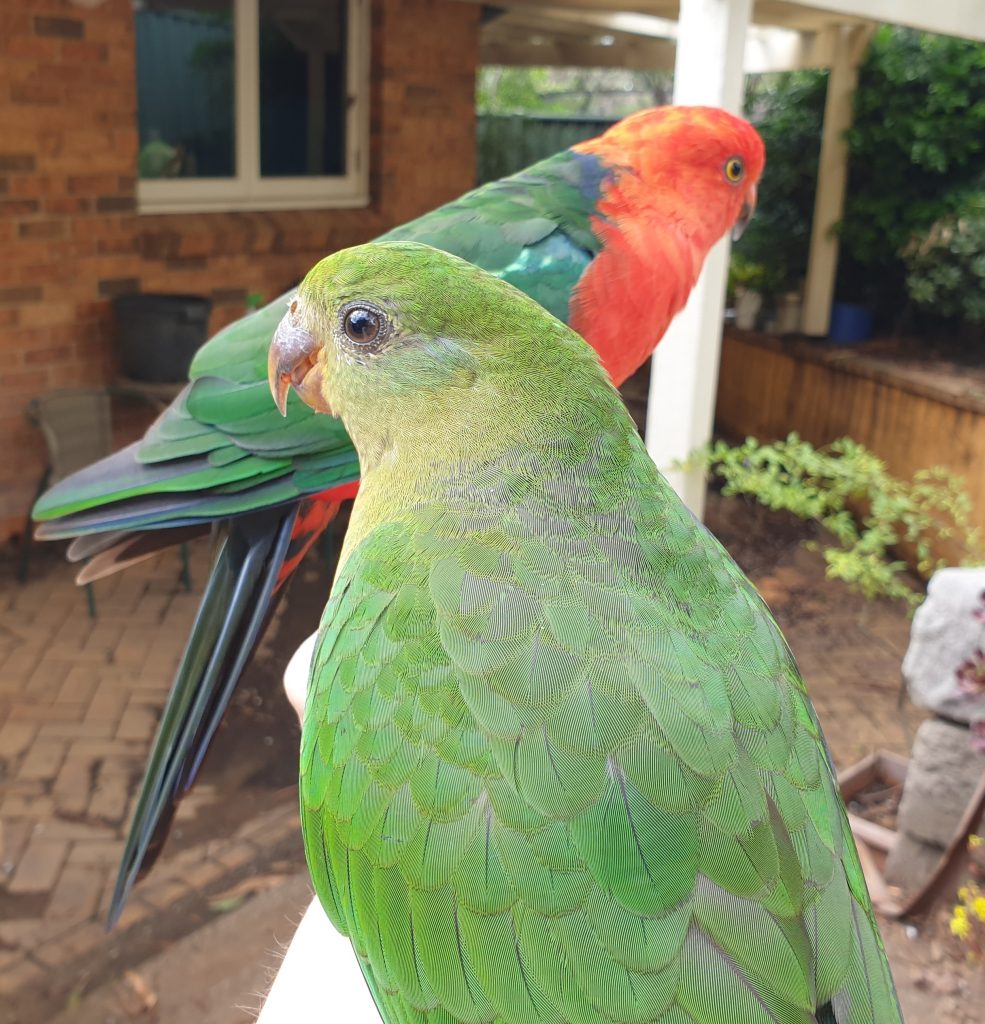
The adult males have a distinctive red head, while the juvenile males and females heads are green. It can be difficult to distinguish between the females and the juvenile males given their similar colouring, however the beak of a female is dark and the adult males is orange. The beaks of the younger King Parrots are also a more yellow colour as seen below.
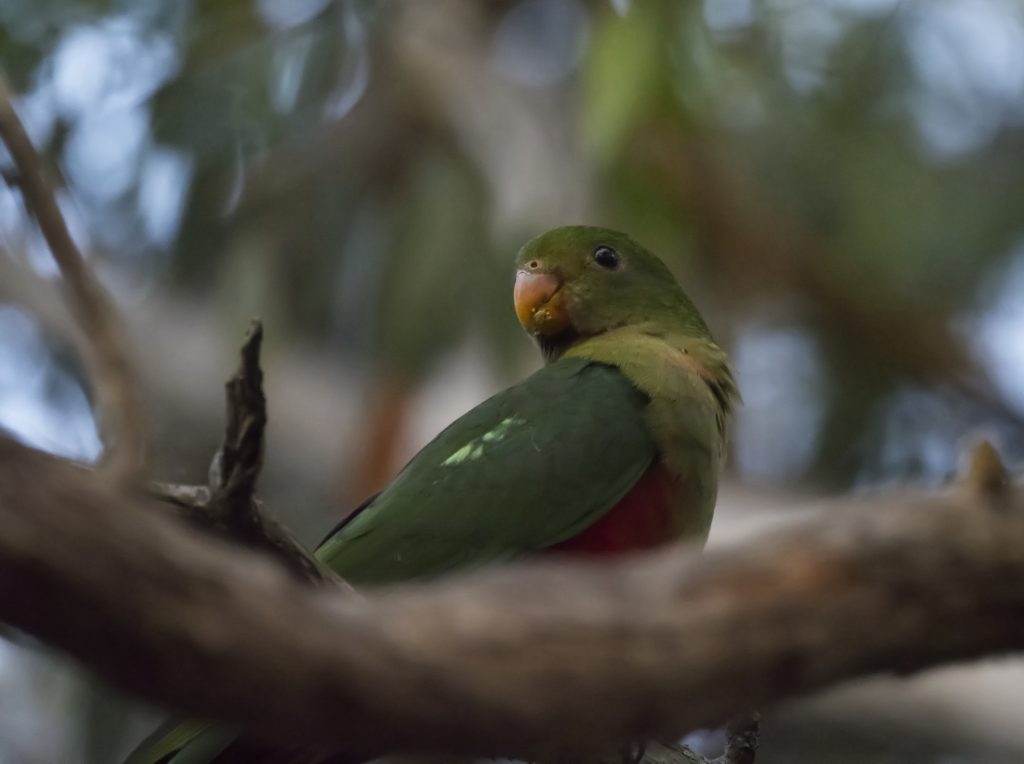
Recently I was outside when one of the females landed nearby, so I turned around to head inside for seed. The instant she saw this she flew to the roof near the step where I always sit to feed them and waited. She flew down to me the instant the seed was in my hand. She remembered! She even followed me into the backyard later, and hopped onto my finger from her branch when I held it up. She lost interest pretty quick when there was no food involved though!
Though you can’t really do much about telling them apart I am pretty sure she visited with another female a few days later, and when I went inside they flew to the chair near my kitchen window where they could wait and watch me coming. They are clever birds!
I don’t generally put food out for these guys anymore as it encourages the spread of disease between them. I make an exception during extreme weather which is likely to effect their food supply, but not often enough that they come to depend on it.
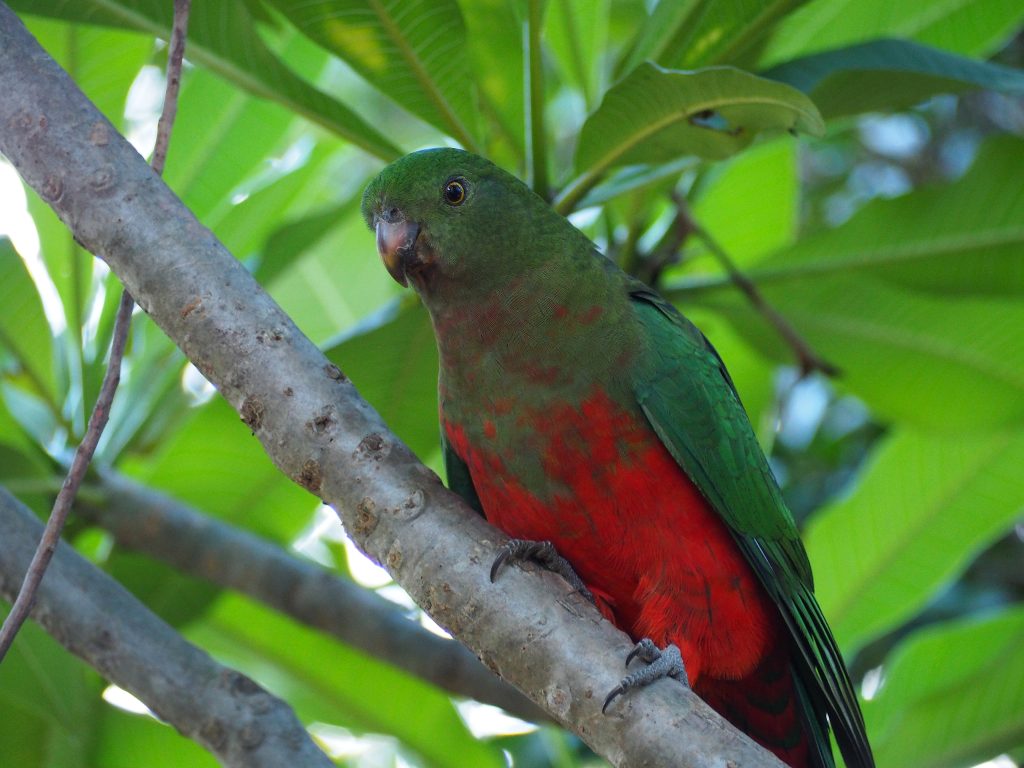
Crimson Rosella
Between the Lorikeets and King Parrots in size, the Rosella’s tend to be a little more timid than their fellow parrots. Frequently when they visit it is on the tail of the King Parrots, which they commonly socialise with.
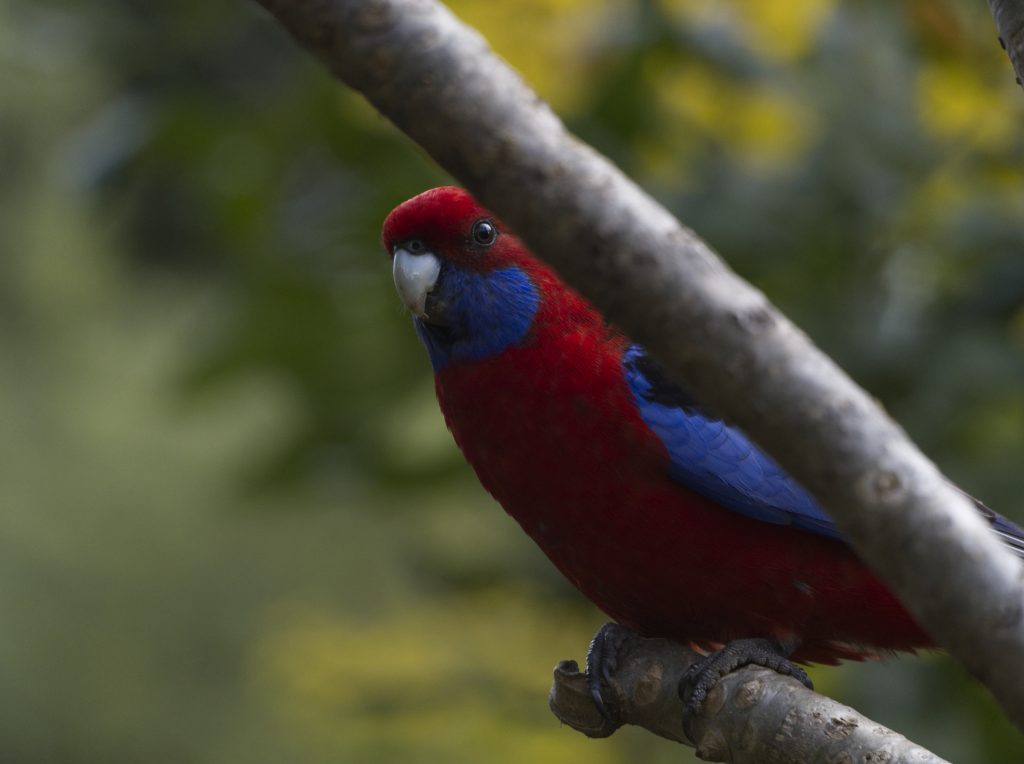
You would need to get up close to tell the difference between the males and females, the males being larger in size and having a bigger beak.
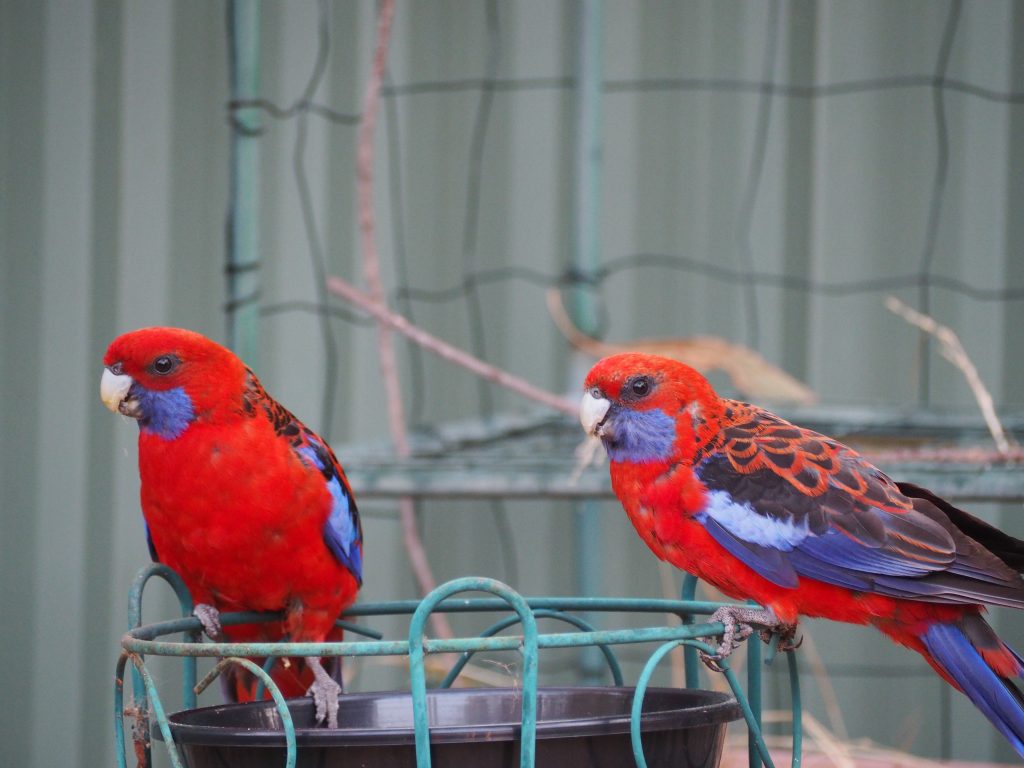
Juveniles however, are quite easily distinguished by the olive green coloured feathers. They will grow into their vivid crimson feathers, you can see the first one above is losing the last of the green. I managed to catch the below one in the background of another shot.
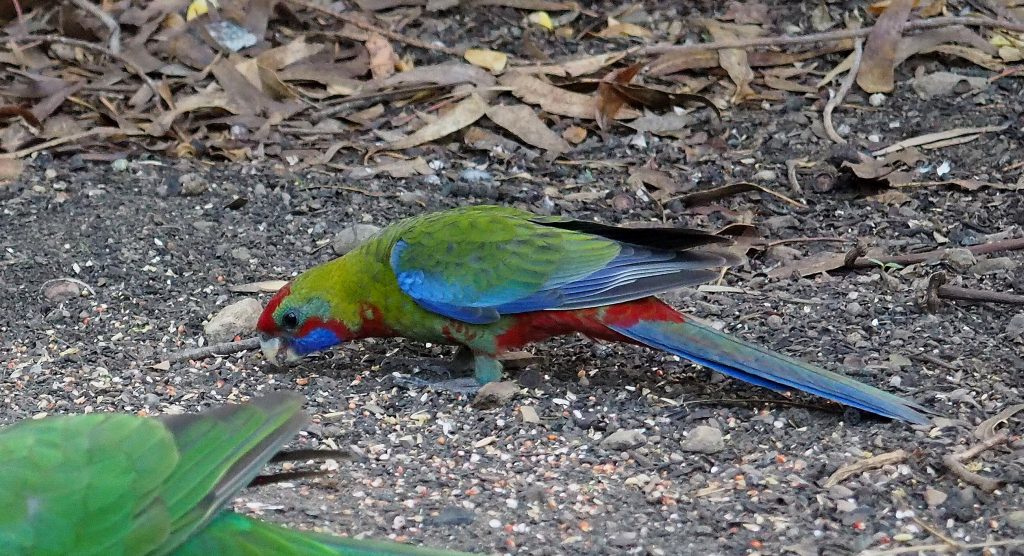
These bright birds don’t get along much with the Lorikeets, and I’ve never seen them around with the Cockatoos either. They are found on the eastern side of Australian and down into Tasmania.
I recently saw an Eastern Rosella, unusual enough that I had to look it up! I’m on a mission to capture one next!
Sulphur-Crested Cockatoo
The distinctive screech of the Sulphur-crested Cockatoo resounds through Australian bushland and suburbia alike. You can’t miss them, they are noisy, and they are massive.
Despite being a royal pain in the proverbial, I can’t help but really like these birds, also a species of Australian Parrot. They are incredibly clever and do the heck as they please. If a bird could flip you the bird, you can guarantee it would be a Sulphur-Crested Cockatoo!
They are also incredibly destructive. Have you seen the video of one ripping down the bird spikes installed on a mountains building? Check it out.
See, they are bloody clever and ever so cheeky! I used to sit outside with my coffee at a mates in the mornings and a Cockatoo would perch on a branch nearby and tear off pieces of the branch and throw them down at me while staring right at me. I swear it was the same bird every time. These guys strut around on the ground like a high school jock with his chest puffed out, confident of the dominance that comes with their size. They can live upwards of 20 years in the wild and the mature females eyes are brown coloured rather than black, though you’d have to get pretty up close and personal to see it!
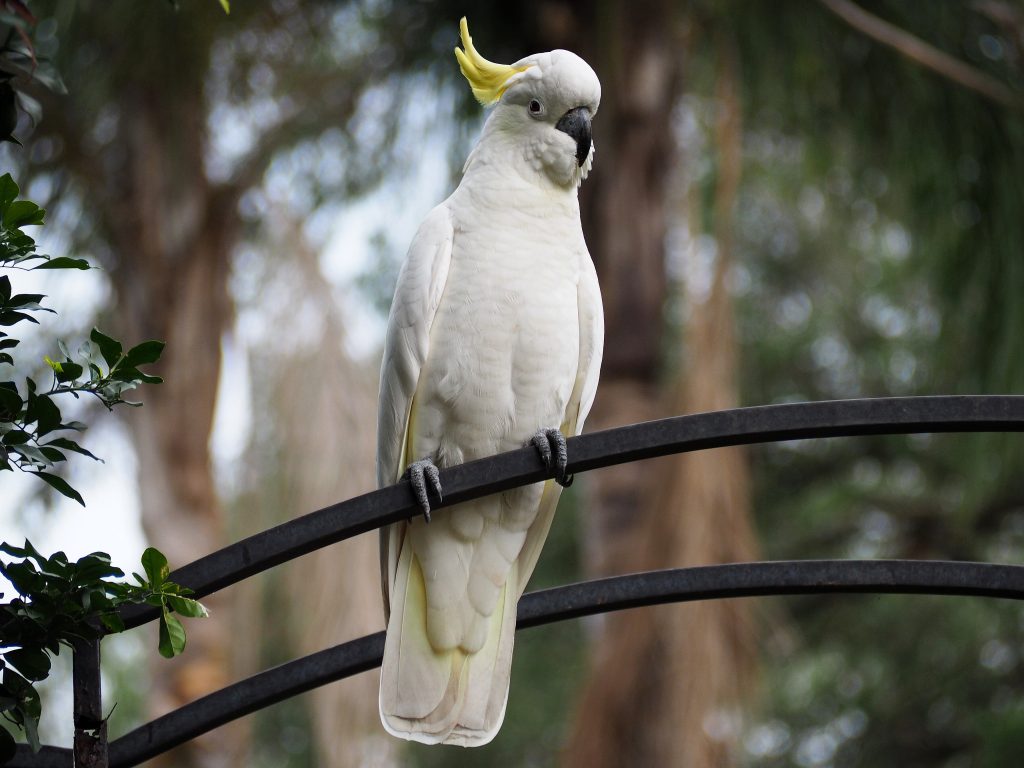
I wish I got less of these to be honest. While I don’t dislike them, they deter the other bird species, such as the Kings, from coming down and they are destructive.
If you’re lucky you might catch a glimpse of their cousins, the Yellow-tailed Black Cockatoo. I hear their calls often. Their cries hold a place in Australian folklore as heralding the coming of rain. These guys tend to avoid people and as such are hard to get a quality shot. I was lucky enough to find a good patch of their favourite food recently, and found an adult male enjoying it with his juvenile. You can identify the males by the red skin around the eye, which is pale in the female. I’ll never stop trying to get better shots of these magnificent fellows! Most people never get the chance to get too close to these to realise how big they are! They are about 2.5 times the size of the Sulphur-Cresteds.
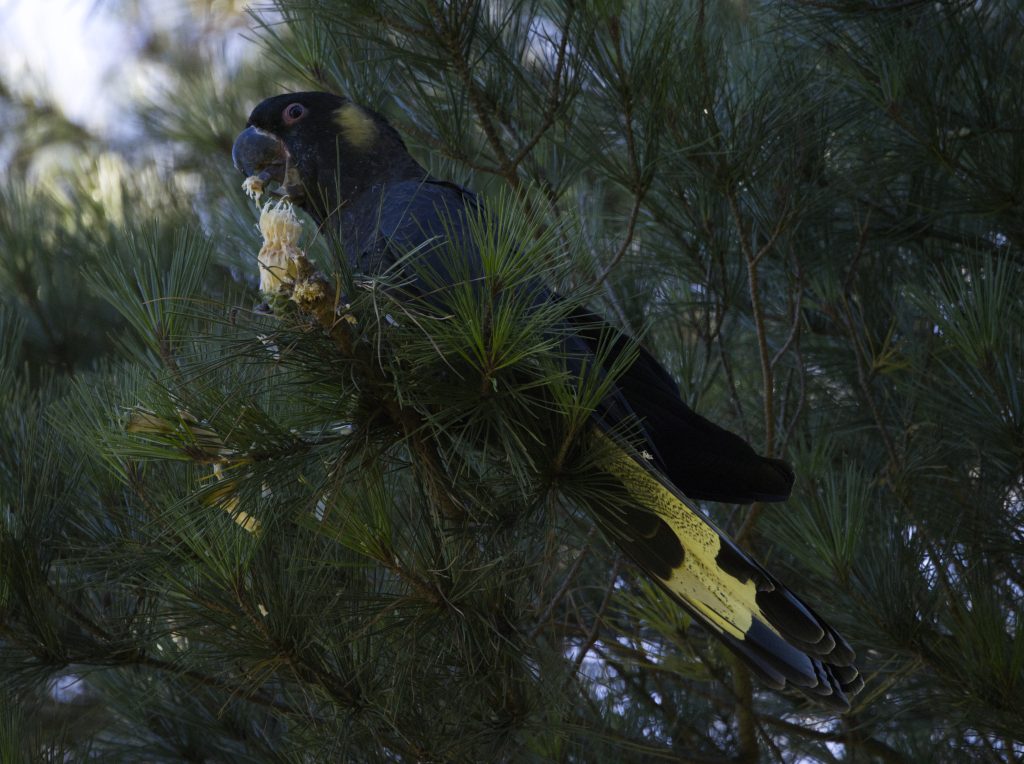
Galah
I don’t actually get these in my yard, I obviously don’t have any food they like, but I am adding them in as they are also a common sight in the Blue Mountains and throughout much of Australia.
Also known as the Rose-breasted Cockatoo, a term I’ve never actually heard anyone use, the difference between the sexes can also be seen in the eyes, but is far more obvious than in the Sulphur-Cresteds. The female Galah has a red iris around the pupil.
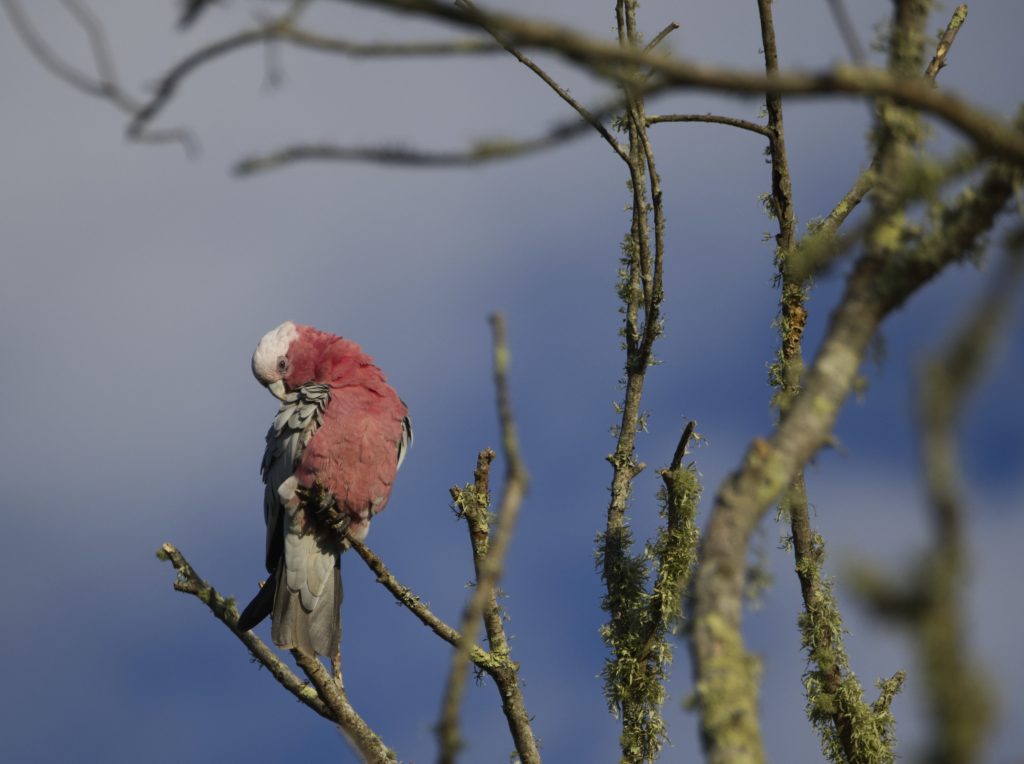
They are known for their playful antics, the source of the Australian slang of calling someone a Galah,
Warning: Parrots in the Blue Mountains have recently been found to have Parrot Fever or Psittacosis, caused by a bacterium which can cause serious illness in humans. Wild parrots should not be handled and care should be taken when exposed to bird droppings.
Australian Magpie
Another bird with a firm place in Australian folklore, the Magpie is the reason that you may see people walking around shielding their heads or riding with cable ties sticking out from their bicycle helmets during the Spring.
The male is notorious for swooping passersby to protect the area in the vicinity of their nests. It’s only happened to me once, walking across my university campus. I didn’t take that shortcut again.
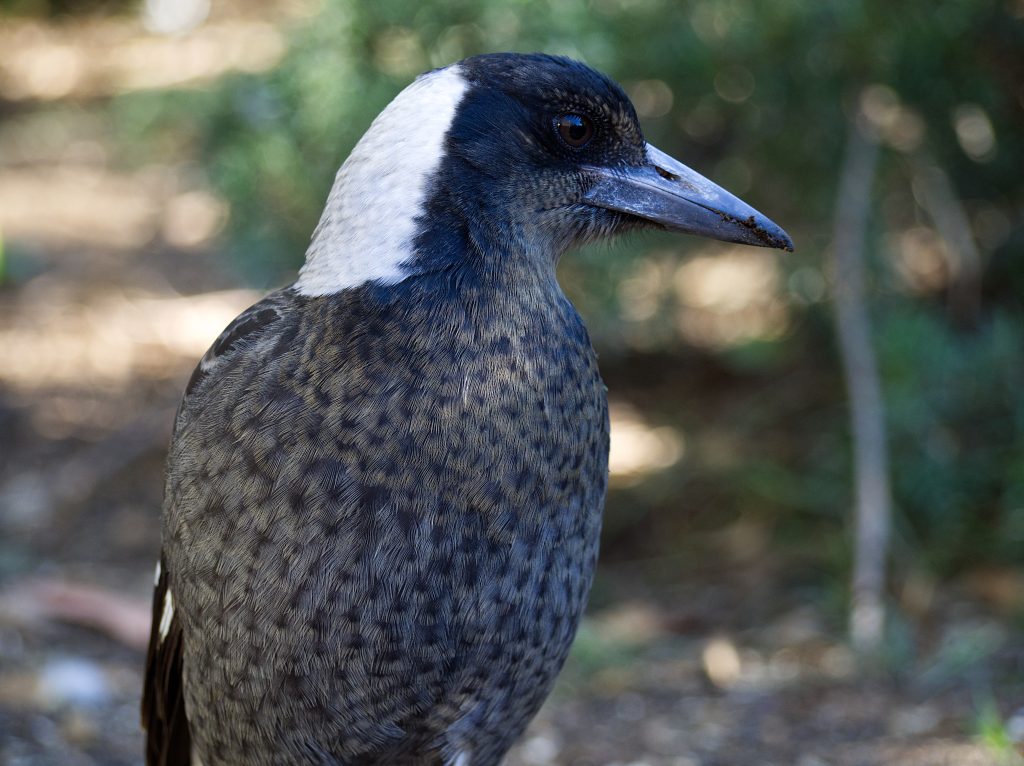
This juvenile visited a couple of times with mum (or dad), and solo on the day I took these shots. This is a female, given the grey feathers at the base of the back of the head evident in the photo above. These feathers are pure white on the male. As she ages the mottled feathers on the chest will change to match the black of the wings.
Australian Magpies are known for their intelligence, and ability to recognise faces. They can also develop a bone disease caused from malnutrition from well-meaning people feeding them inappropriate food, and mince can get stuck to the roof of their beaks and go bad. If you wish to make friends with your locals they will happily eat mealworms or crickets, and once they know you are friendly they will remember you. I have a nesting pair in my neighbors yard that come down to visit regularly, and have even been known to peck at my glass door for attention. They will bring their new fledglings down to meet me every season.
They are also curious and bold. This one had no reservations strolling right up for a closer look, I was worried about my lens getting pecked!
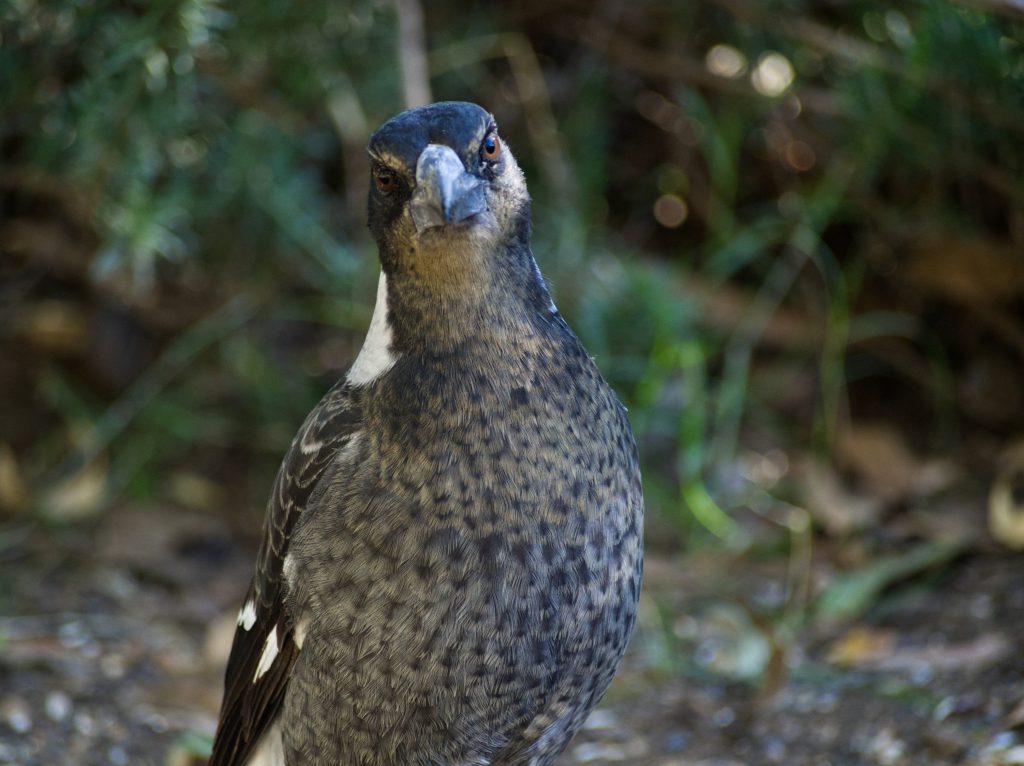
I have to say I was pretty chuffed it wasn’t afraid to come check me out for a closer look! I’d love to know if this is the same bird now nesting nearby. If it is, this is how she looks as an adult.
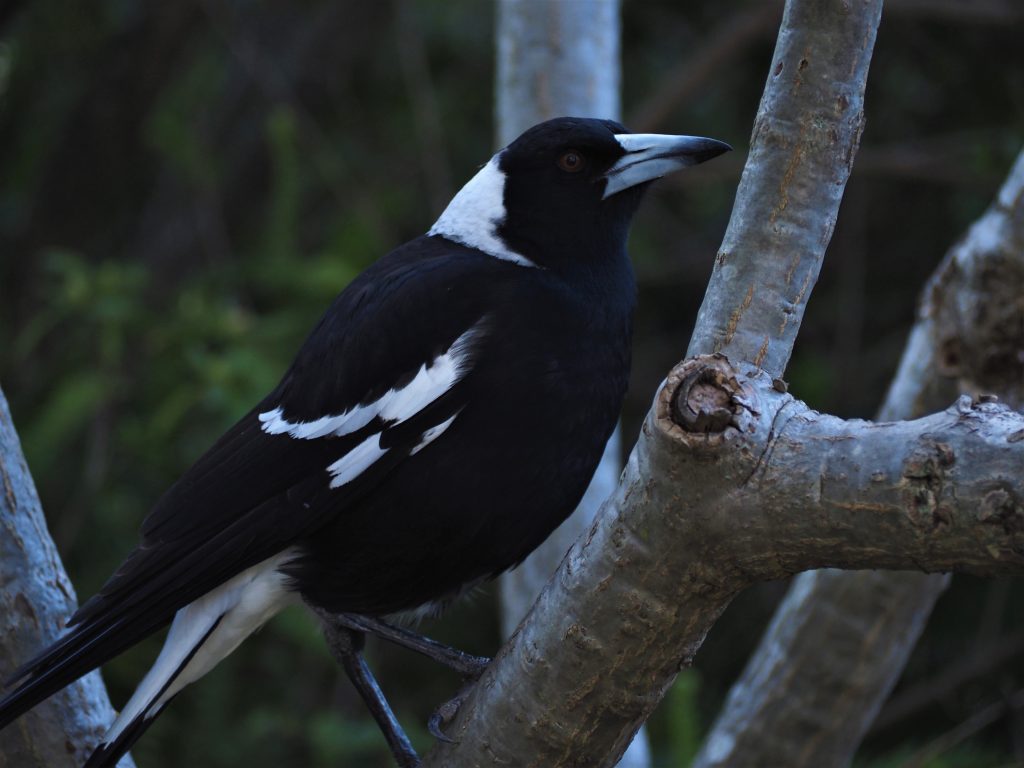
And here is the adult male, you can see why they look pretty scary!
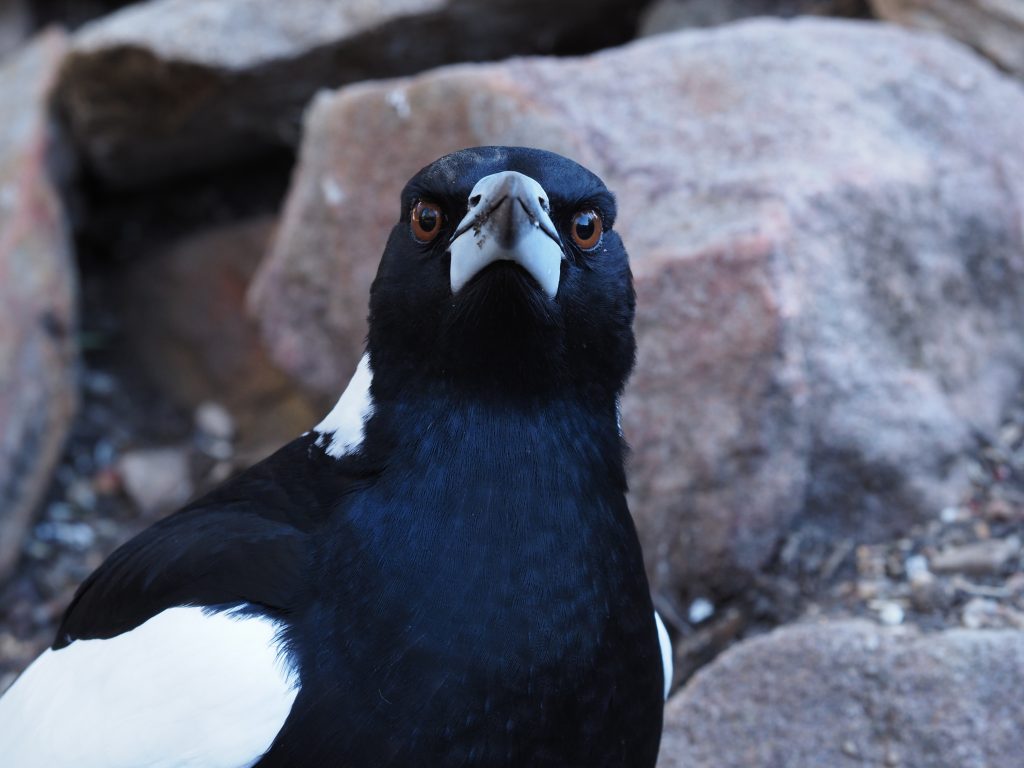
Magpies are common throughout Australia and if you have spent any time near bushland you will definitely have heard their distinctive and beautiful song.
Grey Butcherbird
I have had a couple of visits from one of these guys but they aren’t frequent visitors, though they are a common Blue Mountains bird. They have a beautiful song but the name is actually fairly descriptive. They like to feed on baby birds and will often hang their food on a branch where they can carve away at it like a butcher.
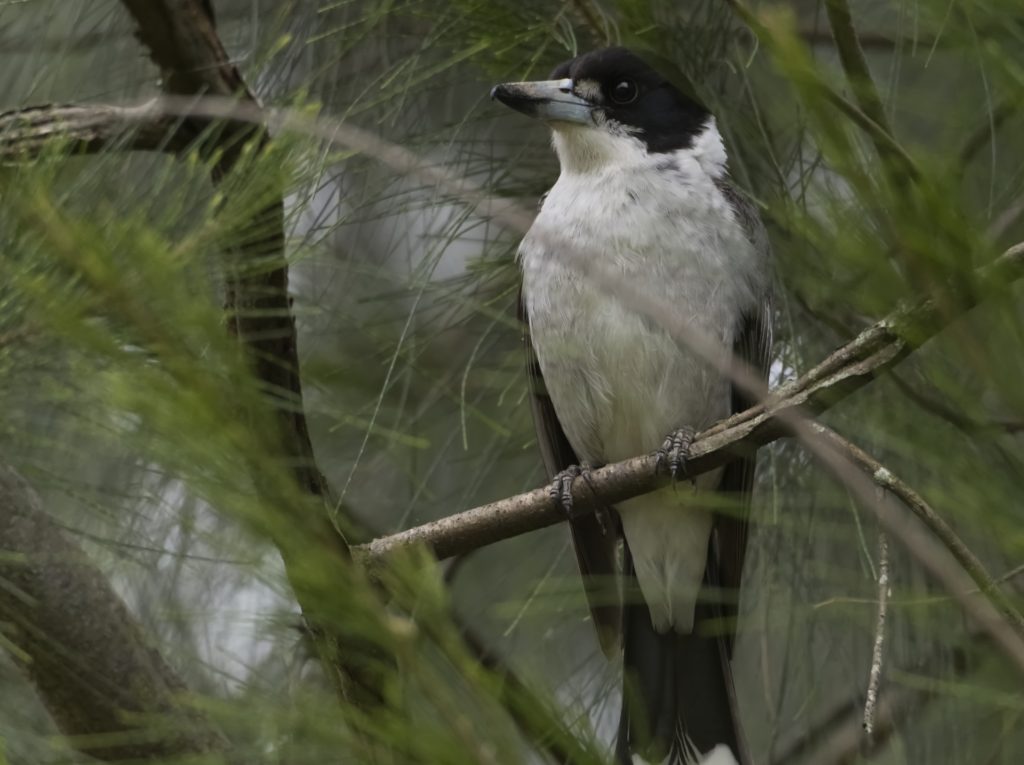
Satin Bowerbird
Another of the Blue Mountains birds presenting a challenge to photograph is the Satin Bowerbird. These birds are fast and startle easily, so getting close enough for a decent photo can be tough. I got this shot one morning after noticing their fondness for my neighbours fruit tree and was able to catch it on a visible branch.
The males don’t get their lovely rich blue colouring until they are about 7 years old, until then the feathers of the male and female look identical, though the female will have a darker beak, so this one is likely a female.
I’ve raised a number of these in the past year and released them at home so I’m fortunate to have a number of them as regular visitors now, though it means my Feijoa’s get decimated before I even get a look in! They are frugivores, so they will eat a combination of fruit, vegetables and insects so your garden is as good as a smorgasboard for them!
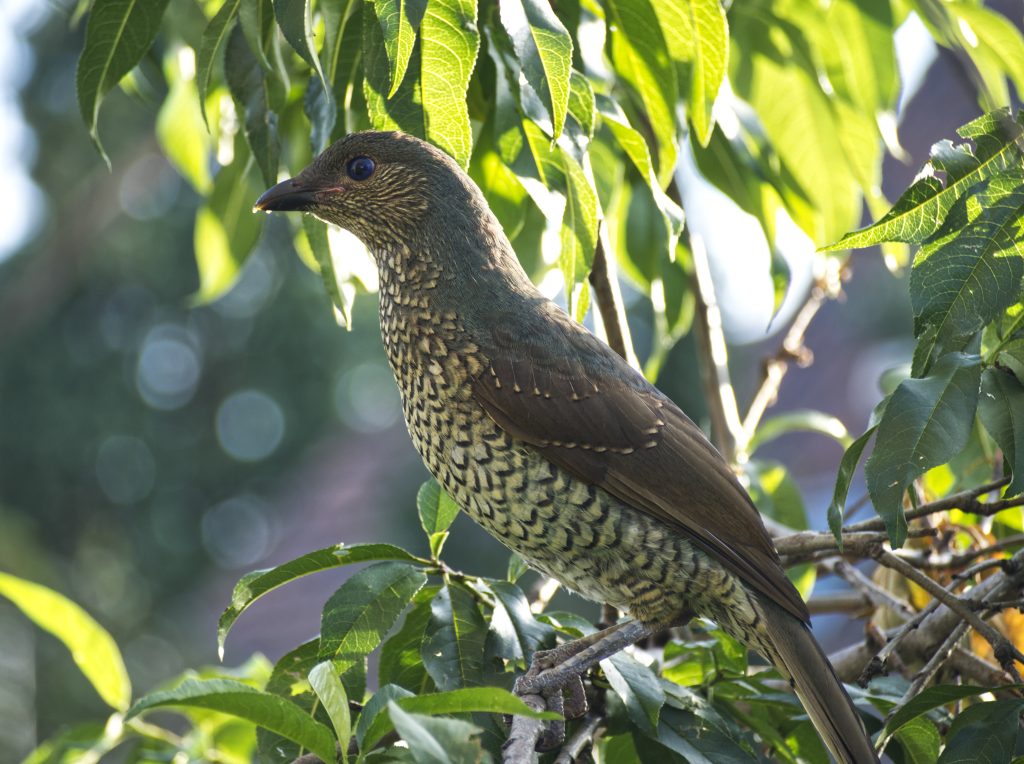
These birds get their name for the bower which the male builds to attract a female for mating, which they will decorate with blue things they have collected. They are known for stealing clothes pegs in the mountains, as well as the blue rings from milk bottles which can cause them an untimely death so please snip them before discarding!
The image below is a Bowerbirds bower I came across on a local bushwalk.
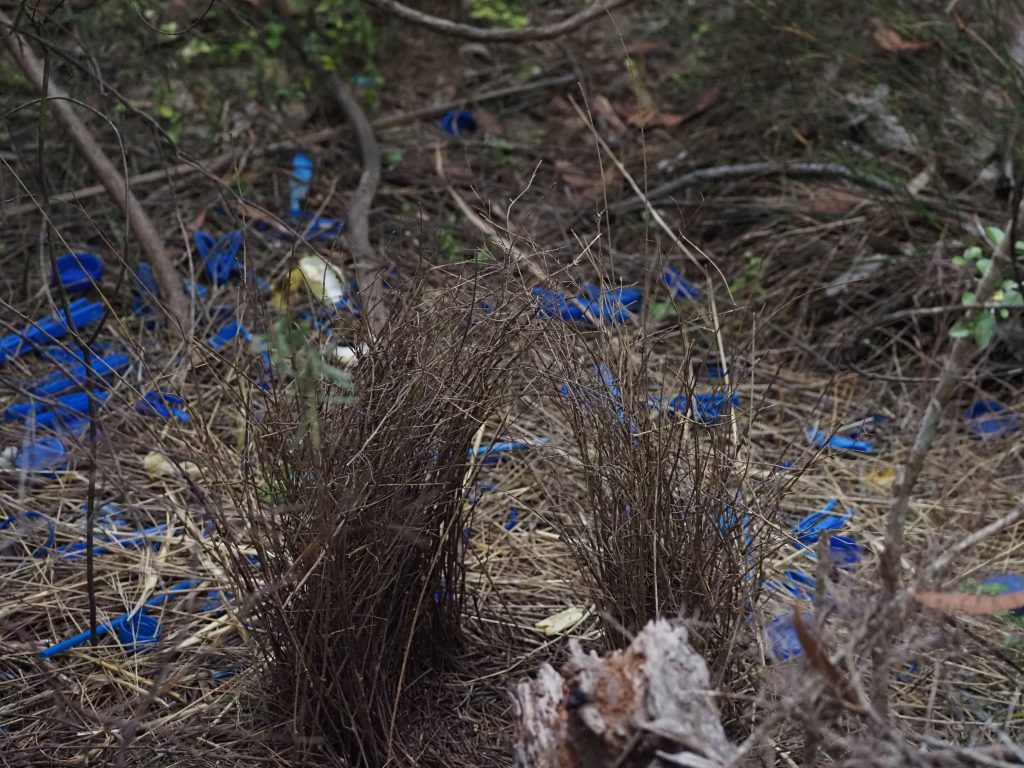
Common Bronzewing
The Common Bronzewing is a variety of native pigeon, so named for the colours on their wings that flash brightly in the sunlight. A number of them decided to call my backyard home for a while, and there was always more males than females, so perhaps my yard was the local bachelor pad!
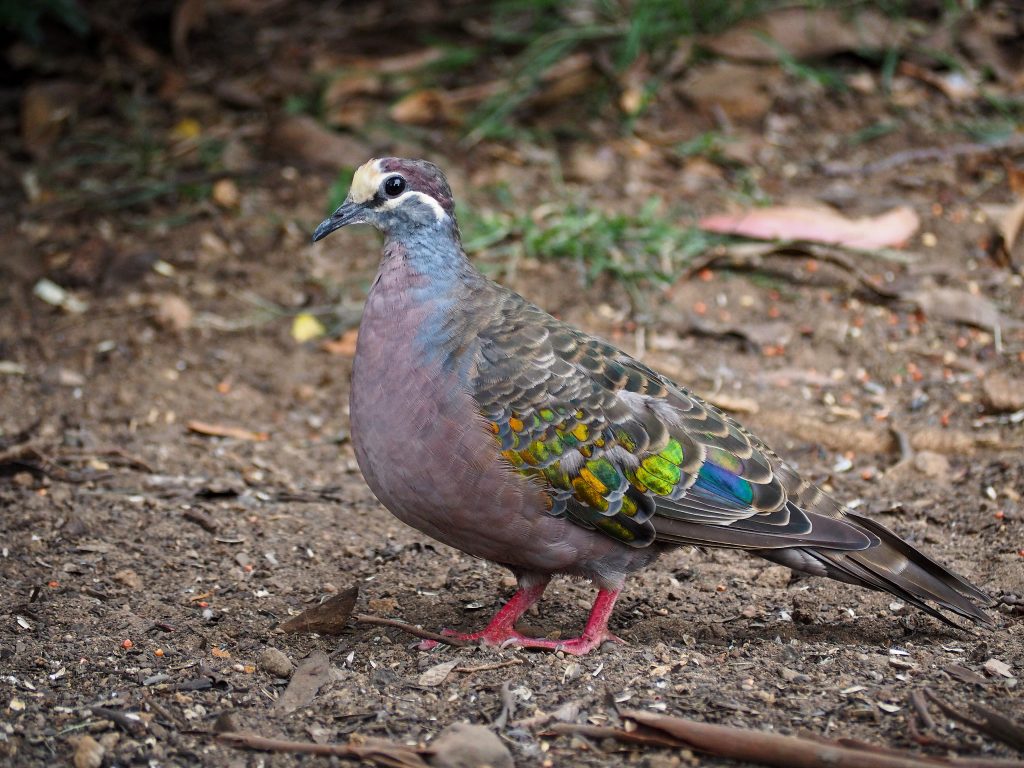
The males are identifiable by the brown forehead which the females are missing.
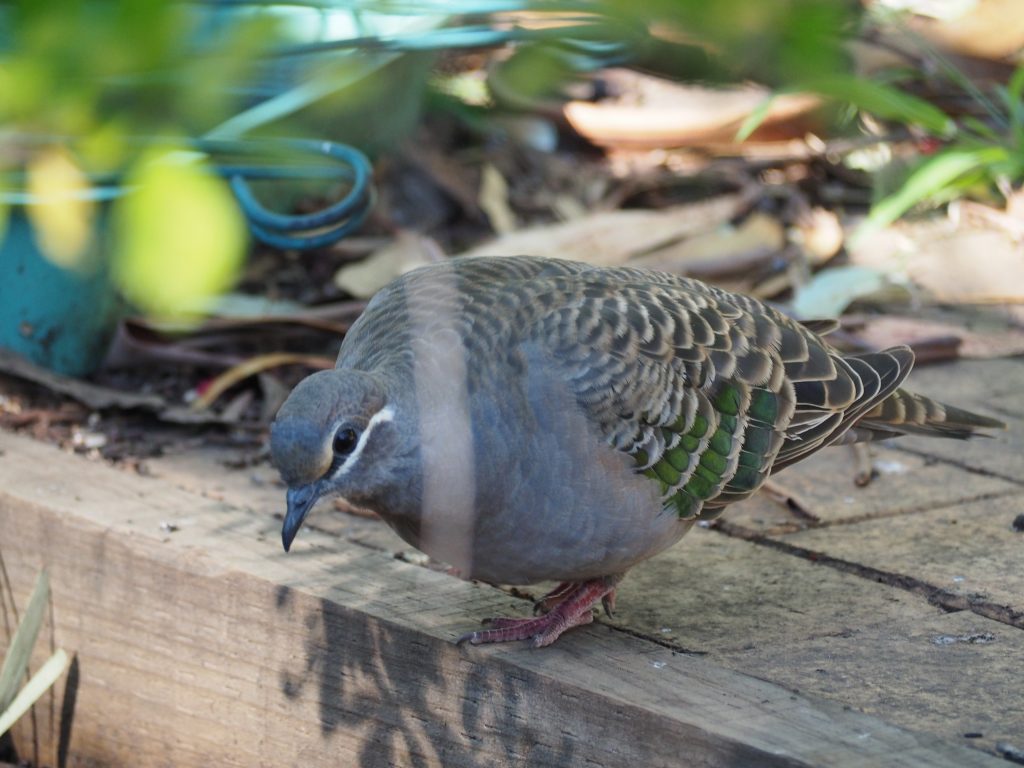
The Bronzewings are pretty at home on the ground, but are timid and will take flight quickly when spooked. They will stay close to water, of which I have a few sources in my yard.
Like Magpies they are known to sunbake.
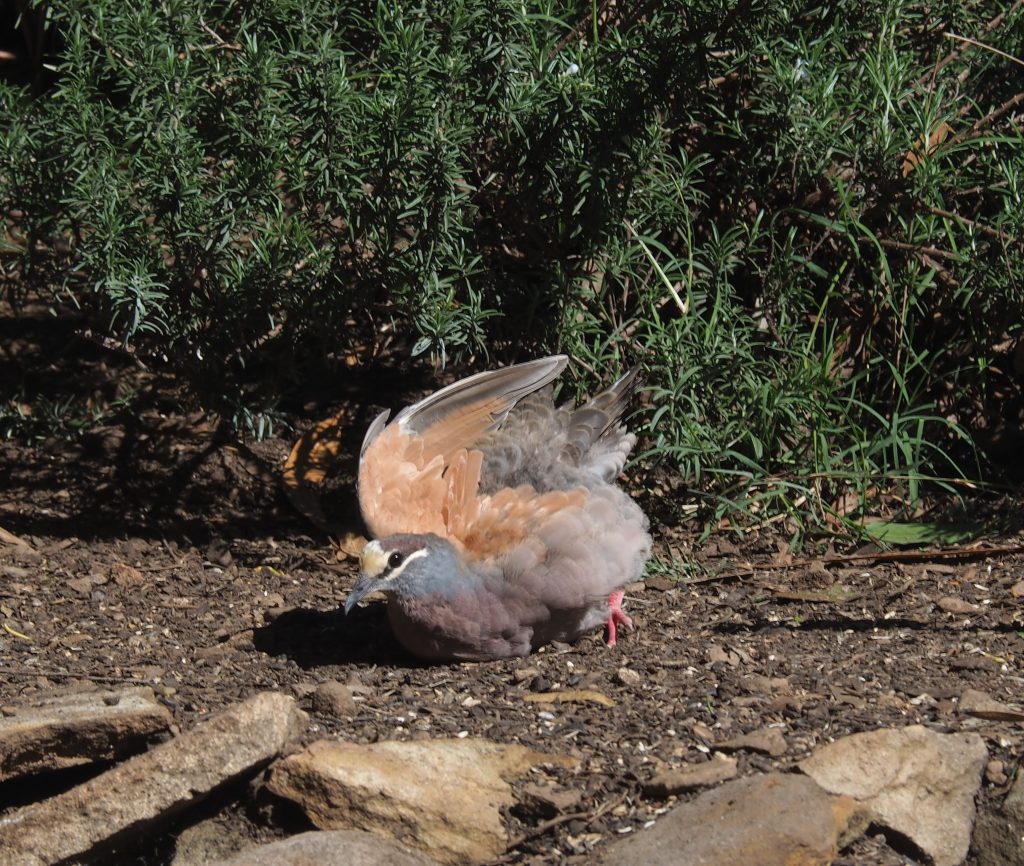
As long as it has access to water, the Bronzewing can live in most habitats.
Crested Pigeon
These guys aren’t a regular, but do pay me the occasional visit. They don’t mind hanging out with the Bronzewings and are similar in having a number of colours in their wing feathers. However they are grey in colour and have a black crest on their head. They are one of only two Australian pigeon’s that have an erect crest. They are found throughout Australia and it is almost impossible to distinguish the males from females.
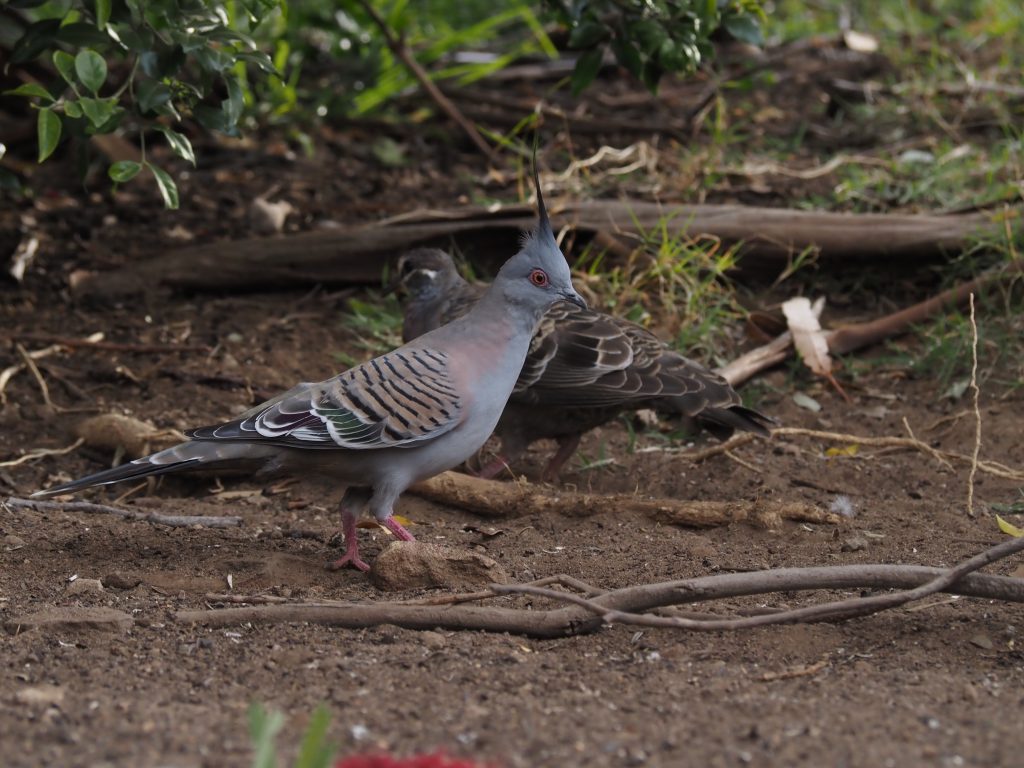
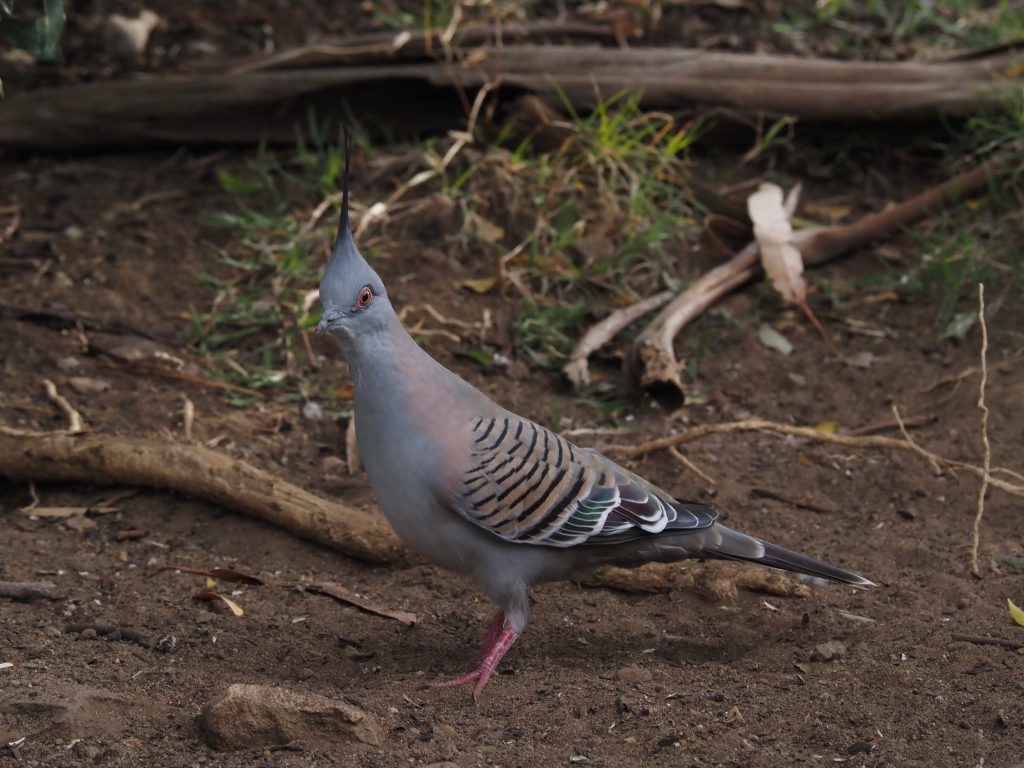
Noisy Miner
Not to be confused with the introduced Indian Minor, the Noisy Miner is an Australian Native.
I was woken by the doorbell one Saturday morning, on what had already been a rather strange weekend. When I opened the door a woman I didn’t know was standing there. She explained she was a Wires carer and a few days prior someone had found two baby birds in their nest in the middle of the road, obviously blown out of a tree. I had actually seen the post on Facebook but not realised it was my street. Since my house was the nearest to where they had been found she wanted my permission to put the cage with the surviving baby bird on my lawn to see if the family would accept it back.
We watched from a safe distance across the road as the adult Miner’s ventured closer and closer to the cage, landing on it to chirp at the chick inside. We continued to watch as she took it out of the cage and put it in the lavender bush nearby. If the adults didn’t feed the chick, it wouldn’t survive and she would have to take it with her.
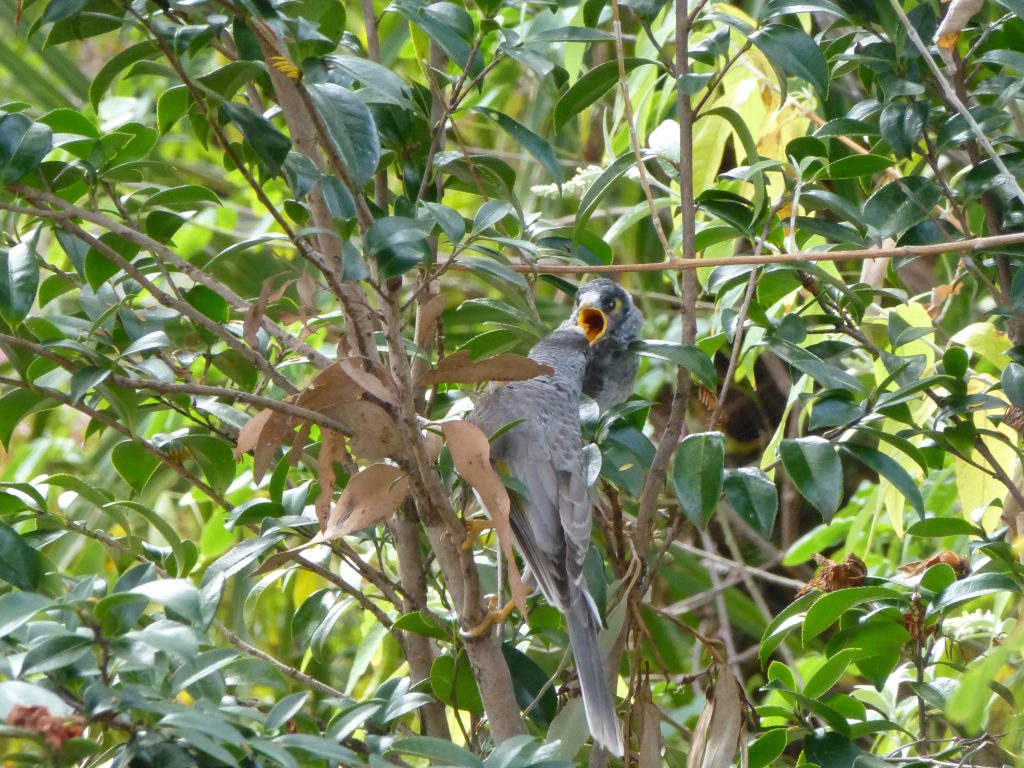
The adults flew in and out of the bush, and eventually we were able to catch a glimpse of the adults feeding the chick. That day piqued my interest in birds, as I found myself watching the adults interact with the chick throughout the rest of the weekend. I’m sure I saw it a few times after that day, but I couldn’t tell the difference anymore, though I am sure the family that frolics in the trees in my backyard is the same one. These days they flit around so fast I can’t get a good photo!
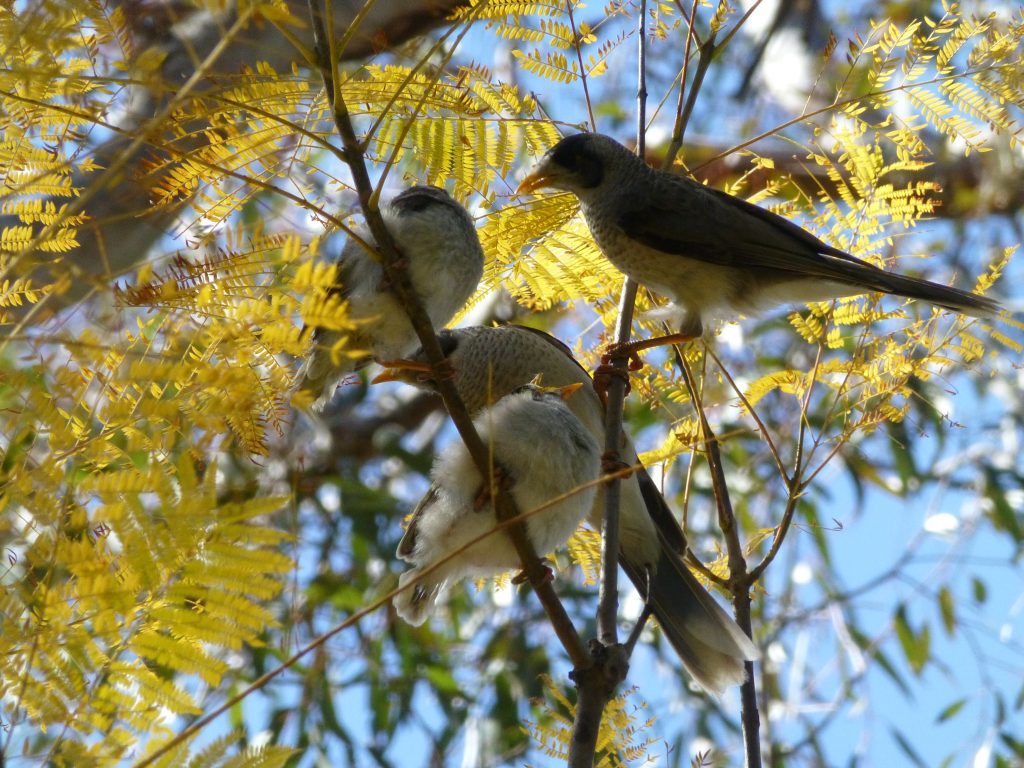
The Noisy Miner is a member of the honeyeater family found in eastern and south-eastern Australia. As the name suggests it makes quite a racket! I’ve had a few of these come into care and they definitely live up to the name, the chicks even cheep in their sleep! When they are quiet you know there is something wrong.
These guys get a bad rap as they are quite territorial and can push out other native birds. They are doting parents and tight family units though, and seem to exist quite comfortably alongside other natives in my yard.
Laughing Kookaburra
Another Australian icon, the Kookaburra is a noisy member of the Kingfisher family. Given I have a fish pond in my backyard, that explains their occasional visits!
They are distinct from the smaller Blue Winged Kookaburra, which is found in the North of Australia
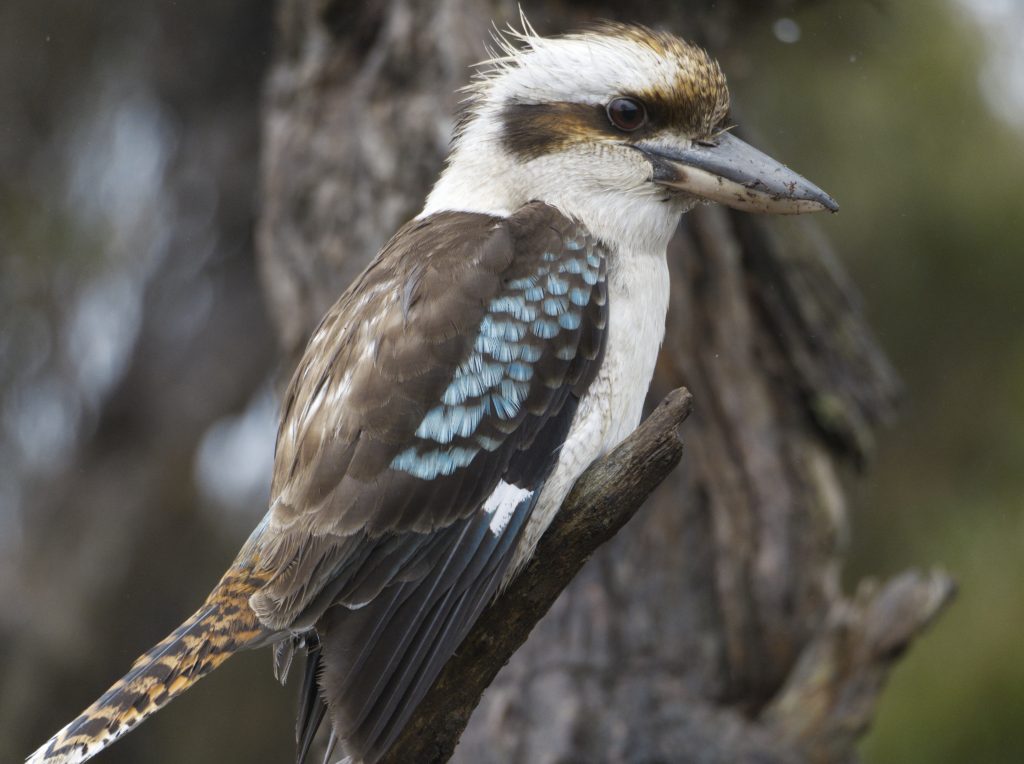
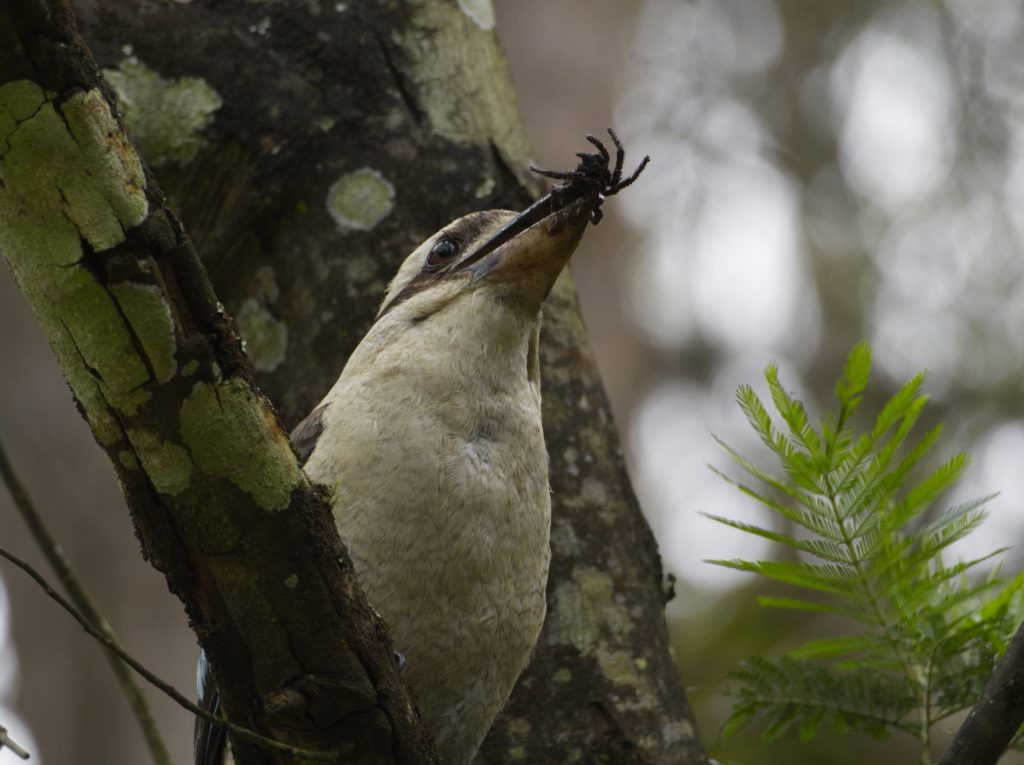
And they do sit in Gum trees, just like the song!
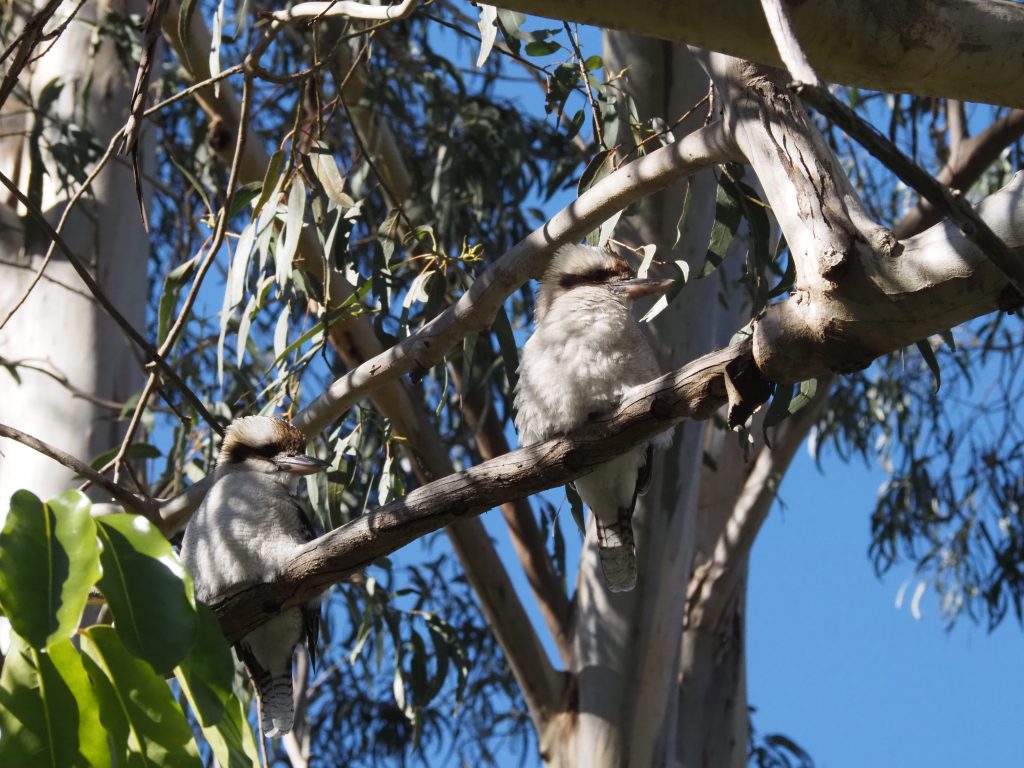
I hope you’ve enjoyed this glimpse into my backyard!
If you are interested in learning more about Australian Native Birds, or taking up Birdwatching, a field guide to Australian birds is an essential item!
My Photography Equipment
If you are interested in what photography equipment I use and recommend, check out some of the results in my Photography Equipment List. You can also check out my favourite Photography Spots in the Blue Mountains.
Where to stay in the Blue Mountains
If you are keen to spend a little more time in the Blue Mountains check out some of the accommodation options below. Why don’t you check out some of the best Blue Mountains waterfalls while you’re here!
If you enjoyed this please share!
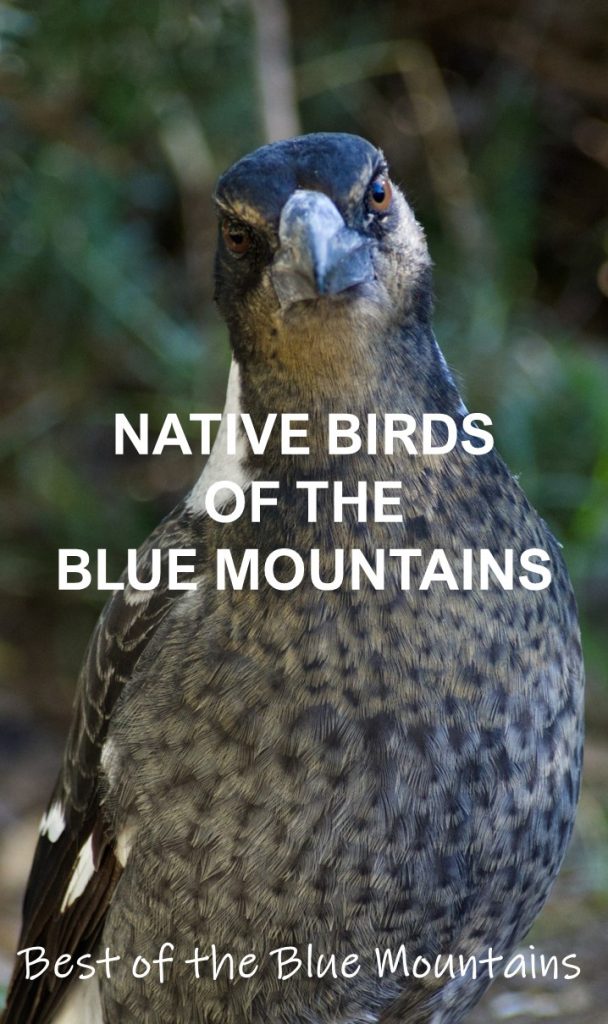
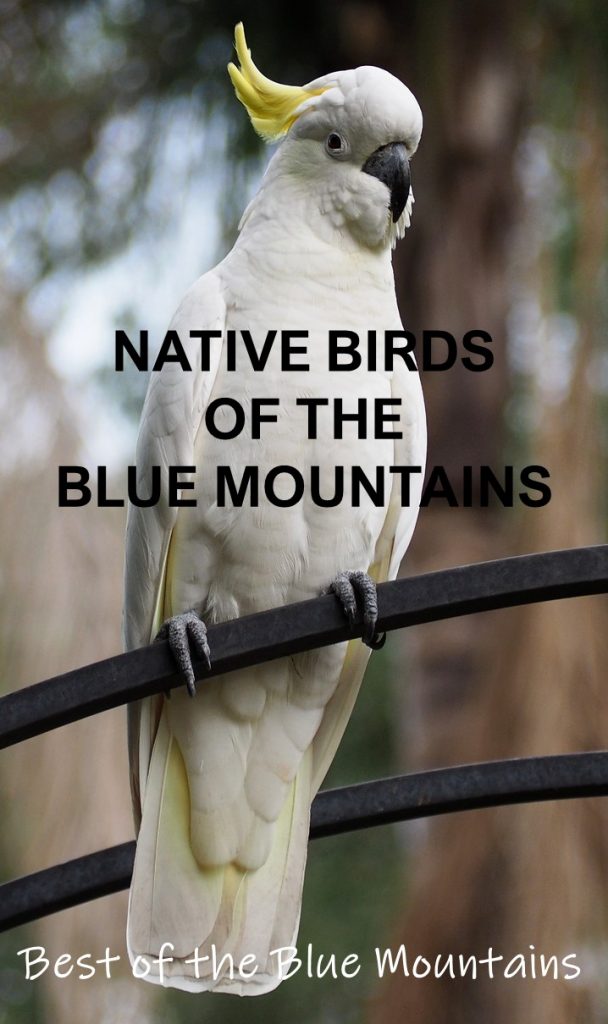
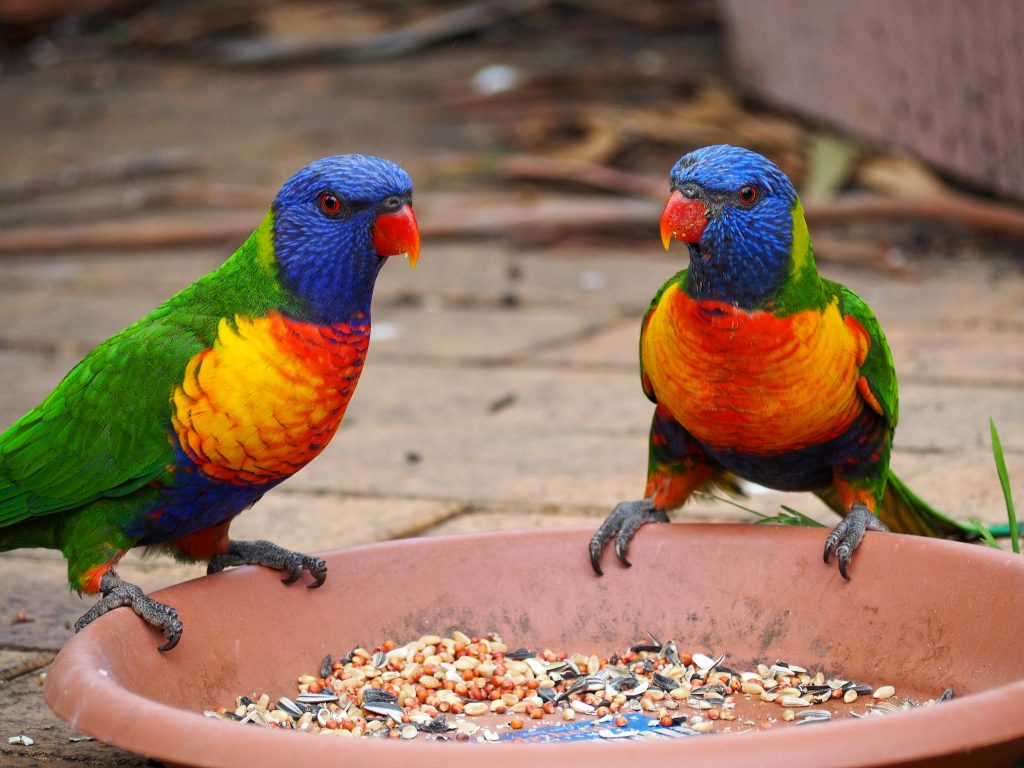
So many beautiful birds! Great photos 🙂
I always knew Australia has extensive wildlife.Good to know about a few. Nice pictures
I had no idea the Blue Mountains had so many amazing native birds!! I’d love to see some of these in their home one day!
Wow, I’m so jealous that you live near the Blue Mountains! I visited there a few years ago and loved it 🙂 I wish I’d read a post like this before I went so I could have kept an eye out for these beautiful birds.
wow, I was in Blue Mountain solo, but that day was so cold, raining, and I was freezing (it’s a summer supposed) and had to walk fast to keep myself warm, even I bought a souvenir hoodie. Haha, unfortunately, either I was not luck to discover those beautiful birds, or I was too distracted by the weather…. But definitely love the wild life in Australia!!! So much wanting to go back again.
Oh my gosh, what a treat to have so many beautiful birds around you. The magpie sounds pretty amusing to me, although I’m sure the people who get sideswiped by them don’t feel that way. Great post!
Oh my goodness! My mom is a huge bird watcher- she would be in love with this area!!! Beautiful photos!
Wow! Those just land in your backyard? And really, onto your arm? That is awesome! I’m trying to get the little fantail birds to land on me, but so far they just hover at my head, lol. Beautiful post!
I’ve been fascinated by the birds in Australia since my first visit! They are so colourful!
I loved reading all about the birds as I have been to the Blue Mountains and have spotted quite a few of them. I have got to say I am just a little bit jealous to hear you live in such a beautiful part of Australia. It’s interesting that your Australian magpie differs quite a bit to the English one. I get so many in my garden and they make an awful noise!! A great post about your locale.
I just loved this. It made me homesick 🙁 I’m originally from Canberra tho I’ve lived in Canada for many years. I’ve seen all these birds in Canberra. And also visited the Blue Mountains. One thing I remember from that visit is a flock of black cockatoos. I think they must be a bit rare as it’s the only time I’ve ever seen them. Anyway thanks for this post. I really enjoyed it.
Gosh your backyard is magnificent! These little beauties must be such a treat to see. You’re so lucky to have then on your doorstep. You got some incredibly stunning pics!
Thank you sharing useful information for us. i always read your blog.
Wonderful information ,dude! Thankyou!
Enjoyed looking through this, very good stuff, appreciate it.